University Business Law Assignment: Partnership Law Analysis
VerifiedAdded on 2022/09/28
|10
|1896
|22
Homework Assignment
AI Summary
This assignment analyzes a business law case concerning a potential partnership among four individuals: Kai, Sen, Luc, and Mitsi. The central issue revolves around whether their collaborative efforts in providing consultancy services to small businesses constitute a legal partnership, despite the absence of formal agreements. The analysis delves into the Partnership Act 1963, examining sections related to partnership formation, joint ownership, revenue sharing, and profit distribution. The assignment applies these legal rules to the facts, considering each individual's contributions, financial arrangements, and intentions to determine if a partnership exists. It also explores the implications of not having formal legal arrangements. The document concludes that the lack of formal legal preparations would not be beneficial for them and that no partnership was established. The analysis also discusses the requirements for establishing a partnership, including tax file numbers, business numbers, mutual management, and liability. The assignment references relevant case law, including Wiltshire v Kuenzli, Smith v Anderson, Wright Prospecting Pty Ltd v Hancock Prospecting Pty Ltd, Friend v Brooker, Spriggs v Federal Commissioner of Taxation, and Seiwa Australia Pty Ltd v Beard to support the arguments.
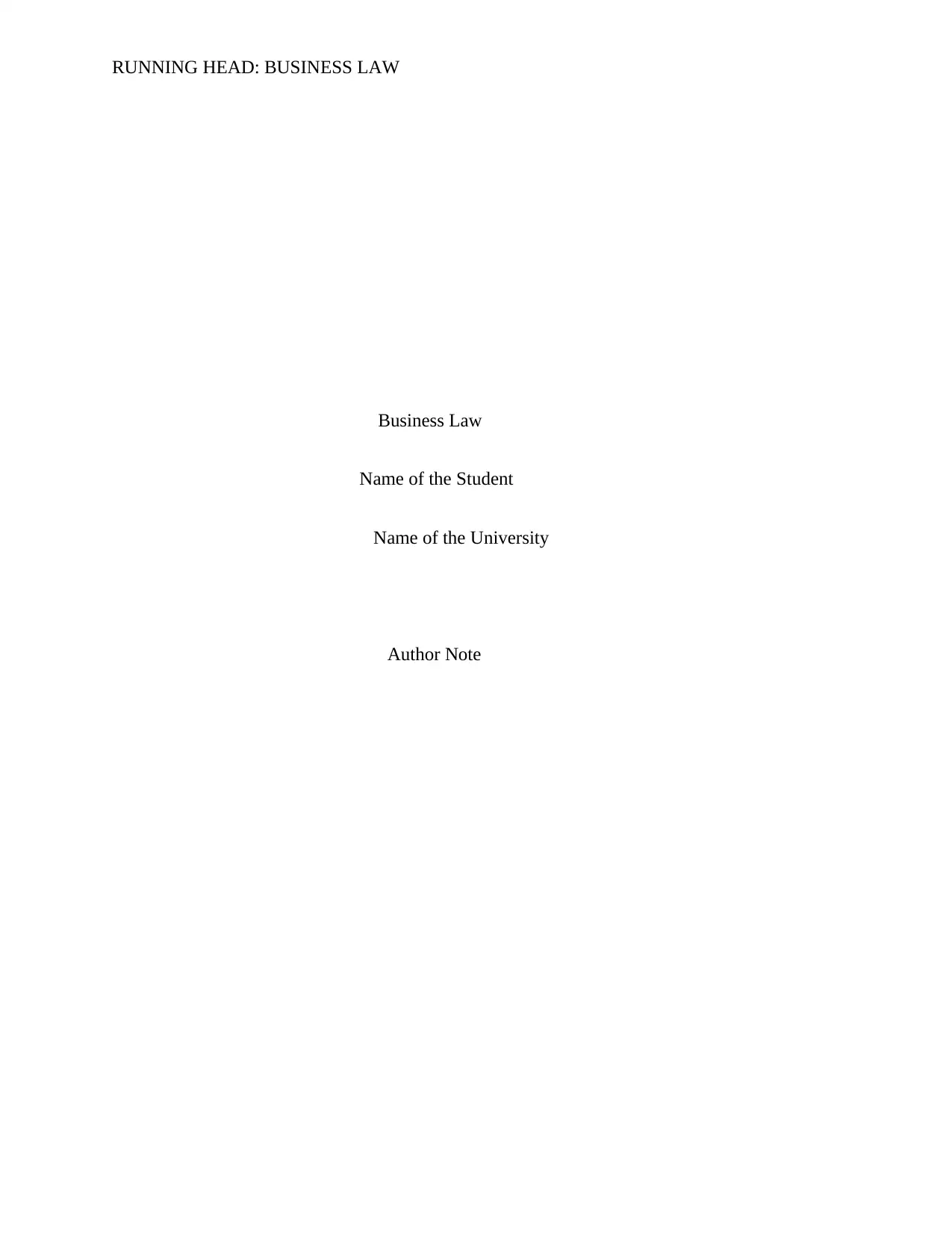
RUNNING HEAD: BUSINESS LAW
Business Law
Name of the Student
Name of the University
Author Note
Business Law
Name of the Student
Name of the University
Author Note
Paraphrase This Document
Need a fresh take? Get an instant paraphrase of this document with our AI Paraphraser
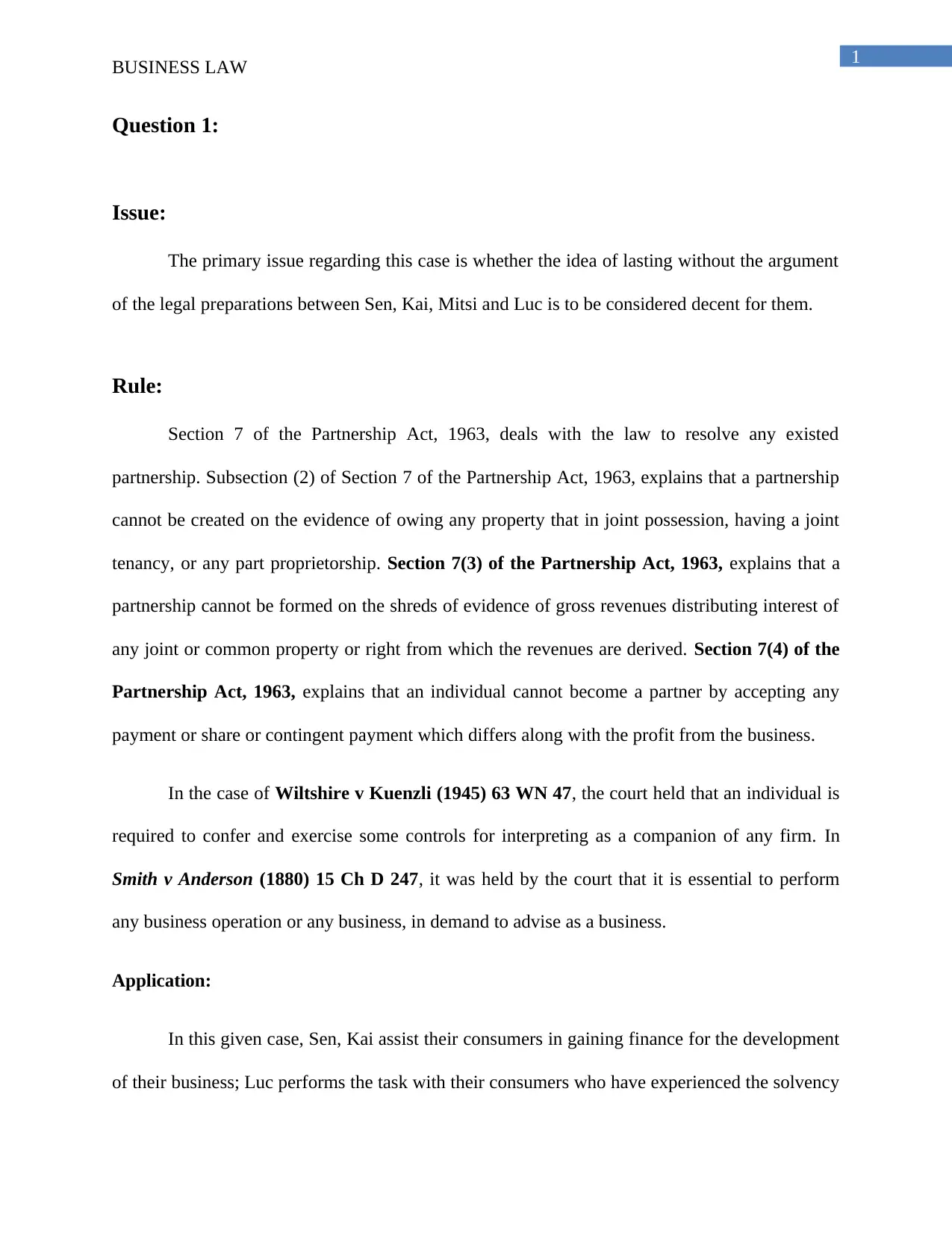
1
BUSINESS LAW
Question 1:
Issue:
The primary issue regarding this case is whether the idea of lasting without the argument
of the legal preparations between Sen, Kai, Mitsi and Luc is to be considered decent for them.
Rule:
Section 7 of the Partnership Act, 1963, deals with the law to resolve any existed
partnership. Subsection (2) of Section 7 of the Partnership Act, 1963, explains that a partnership
cannot be created on the evidence of owing any property that in joint possession, having a joint
tenancy, or any part proprietorship. Section 7(3) of the Partnership Act, 1963, explains that a
partnership cannot be formed on the shreds of evidence of gross revenues distributing interest of
any joint or common property or right from which the revenues are derived. Section 7(4) of the
Partnership Act, 1963, explains that an individual cannot become a partner by accepting any
payment or share or contingent payment which differs along with the profit from the business.
In the case of Wiltshire v Kuenzli (1945) 63 WN 47, the court held that an individual is
required to confer and exercise some controls for interpreting as a companion of any firm. In
Smith v Anderson (1880) 15 Ch D 247, it was held by the court that it is essential to perform
any business operation or any business, in demand to advise as a business.
Application:
In this given case, Sen, Kai assist their consumers in gaining finance for the development
of their business; Luc performs the task with their consumers who have experienced the solvency
BUSINESS LAW
Question 1:
Issue:
The primary issue regarding this case is whether the idea of lasting without the argument
of the legal preparations between Sen, Kai, Mitsi and Luc is to be considered decent for them.
Rule:
Section 7 of the Partnership Act, 1963, deals with the law to resolve any existed
partnership. Subsection (2) of Section 7 of the Partnership Act, 1963, explains that a partnership
cannot be created on the evidence of owing any property that in joint possession, having a joint
tenancy, or any part proprietorship. Section 7(3) of the Partnership Act, 1963, explains that a
partnership cannot be formed on the shreds of evidence of gross revenues distributing interest of
any joint or common property or right from which the revenues are derived. Section 7(4) of the
Partnership Act, 1963, explains that an individual cannot become a partner by accepting any
payment or share or contingent payment which differs along with the profit from the business.
In the case of Wiltshire v Kuenzli (1945) 63 WN 47, the court held that an individual is
required to confer and exercise some controls for interpreting as a companion of any firm. In
Smith v Anderson (1880) 15 Ch D 247, it was held by the court that it is essential to perform
any business operation or any business, in demand to advise as a business.
Application:
In this given case, Sen, Kai assist their consumers in gaining finance for the development
of their business; Luc performs the task with their consumers who have experienced the solvency
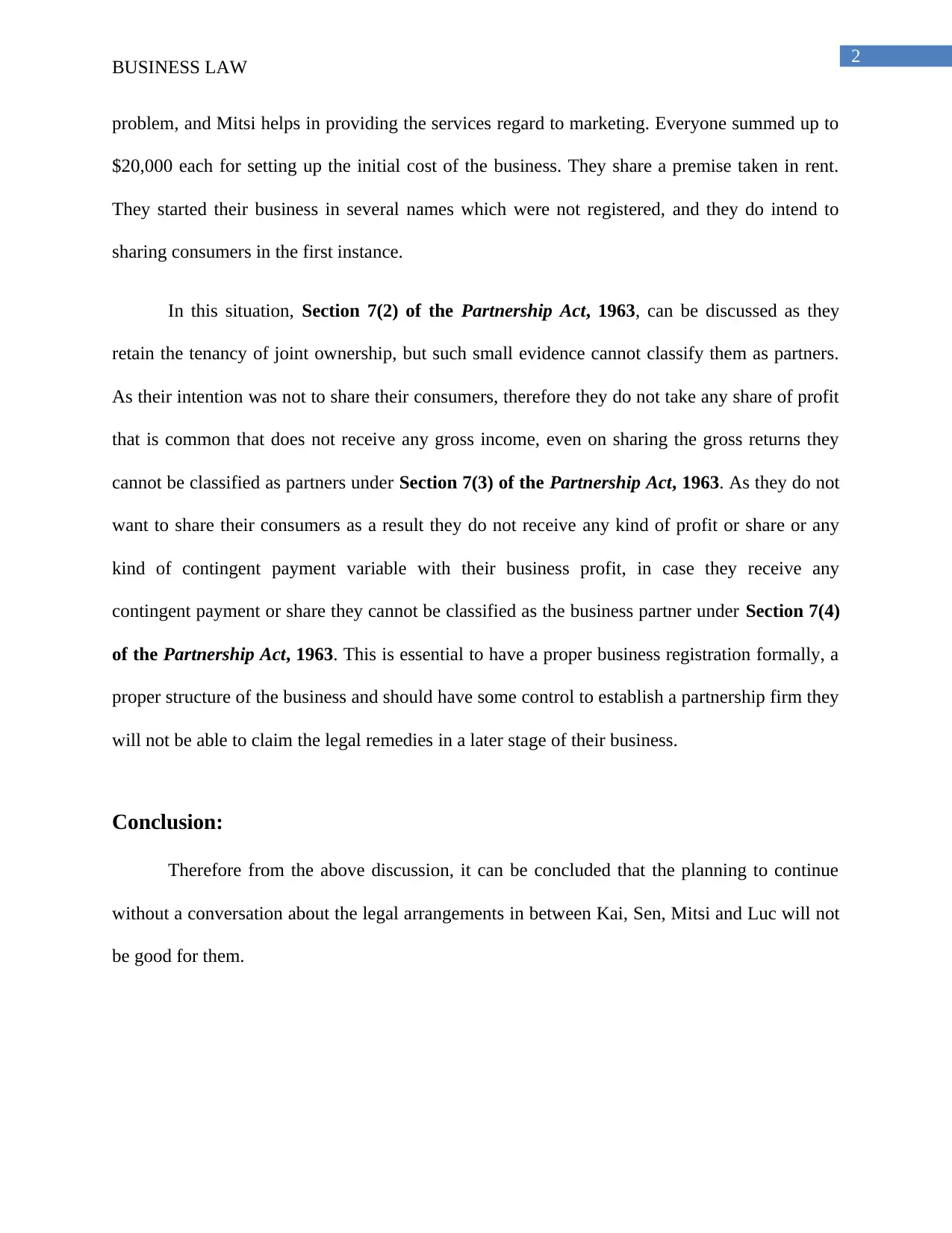
2
BUSINESS LAW
problem, and Mitsi helps in providing the services regard to marketing. Everyone summed up to
$20,000 each for setting up the initial cost of the business. They share a premise taken in rent.
They started their business in several names which were not registered, and they do intend to
sharing consumers in the first instance.
In this situation, Section 7(2) of the Partnership Act, 1963, can be discussed as they
retain the tenancy of joint ownership, but such small evidence cannot classify them as partners.
As their intention was not to share their consumers, therefore they do not take any share of profit
that is common that does not receive any gross income, even on sharing the gross returns they
cannot be classified as partners under Section 7(3) of the Partnership Act, 1963. As they do not
want to share their consumers as a result they do not receive any kind of profit or share or any
kind of contingent payment variable with their business profit, in case they receive any
contingent payment or share they cannot be classified as the business partner under Section 7(4)
of the Partnership Act, 1963. This is essential to have a proper business registration formally, a
proper structure of the business and should have some control to establish a partnership firm they
will not be able to claim the legal remedies in a later stage of their business.
Conclusion:
Therefore from the above discussion, it can be concluded that the planning to continue
without a conversation about the legal arrangements in between Kai, Sen, Mitsi and Luc will not
be good for them.
BUSINESS LAW
problem, and Mitsi helps in providing the services regard to marketing. Everyone summed up to
$20,000 each for setting up the initial cost of the business. They share a premise taken in rent.
They started their business in several names which were not registered, and they do intend to
sharing consumers in the first instance.
In this situation, Section 7(2) of the Partnership Act, 1963, can be discussed as they
retain the tenancy of joint ownership, but such small evidence cannot classify them as partners.
As their intention was not to share their consumers, therefore they do not take any share of profit
that is common that does not receive any gross income, even on sharing the gross returns they
cannot be classified as partners under Section 7(3) of the Partnership Act, 1963. As they do not
want to share their consumers as a result they do not receive any kind of profit or share or any
kind of contingent payment variable with their business profit, in case they receive any
contingent payment or share they cannot be classified as the business partner under Section 7(4)
of the Partnership Act, 1963. This is essential to have a proper business registration formally, a
proper structure of the business and should have some control to establish a partnership firm they
will not be able to claim the legal remedies in a later stage of their business.
Conclusion:
Therefore from the above discussion, it can be concluded that the planning to continue
without a conversation about the legal arrangements in between Kai, Sen, Mitsi and Luc will not
be good for them.
⊘ This is a preview!⊘
Do you want full access?
Subscribe today to unlock all pages.

Trusted by 1+ million students worldwide
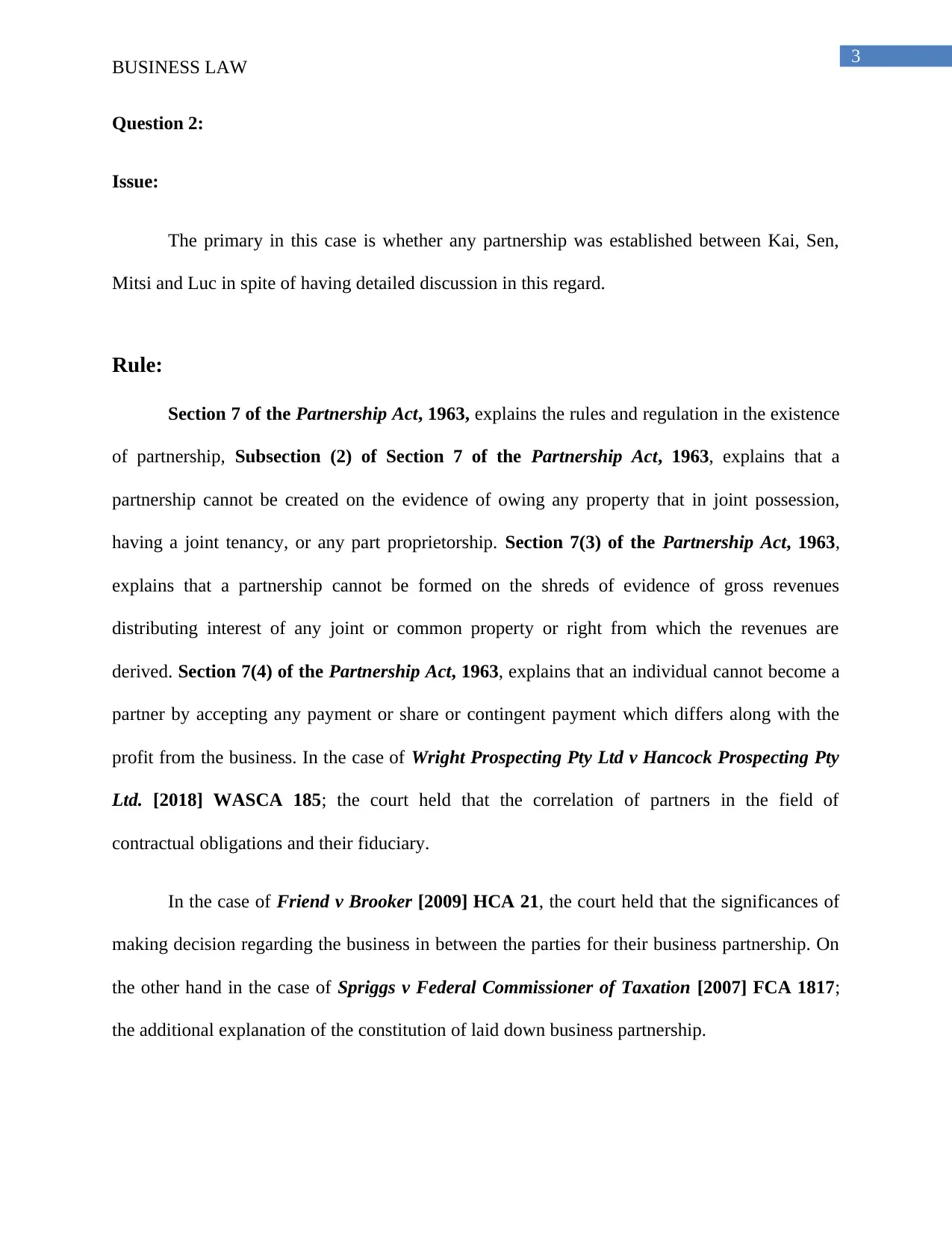
3
BUSINESS LAW
Question 2:
Issue:
The primary in this case is whether any partnership was established between Kai, Sen,
Mitsi and Luc in spite of having detailed discussion in this regard.
Rule:
Section 7 of the Partnership Act, 1963, explains the rules and regulation in the existence
of partnership, Subsection (2) of Section 7 of the Partnership Act, 1963, explains that a
partnership cannot be created on the evidence of owing any property that in joint possession,
having a joint tenancy, or any part proprietorship. Section 7(3) of the Partnership Act, 1963,
explains that a partnership cannot be formed on the shreds of evidence of gross revenues
distributing interest of any joint or common property or right from which the revenues are
derived. Section 7(4) of the Partnership Act, 1963, explains that an individual cannot become a
partner by accepting any payment or share or contingent payment which differs along with the
profit from the business. In the case of Wright Prospecting Pty Ltd v Hancock Prospecting Pty
Ltd. [2018] WASCA 185; the court held that the correlation of partners in the field of
contractual obligations and their fiduciary.
In the case of Friend v Brooker [2009] HCA 21, the court held that the significances of
making decision regarding the business in between the parties for their business partnership. On
the other hand in the case of Spriggs v Federal Commissioner of Taxation [2007] FCA 1817;
the additional explanation of the constitution of laid down business partnership.
BUSINESS LAW
Question 2:
Issue:
The primary in this case is whether any partnership was established between Kai, Sen,
Mitsi and Luc in spite of having detailed discussion in this regard.
Rule:
Section 7 of the Partnership Act, 1963, explains the rules and regulation in the existence
of partnership, Subsection (2) of Section 7 of the Partnership Act, 1963, explains that a
partnership cannot be created on the evidence of owing any property that in joint possession,
having a joint tenancy, or any part proprietorship. Section 7(3) of the Partnership Act, 1963,
explains that a partnership cannot be formed on the shreds of evidence of gross revenues
distributing interest of any joint or common property or right from which the revenues are
derived. Section 7(4) of the Partnership Act, 1963, explains that an individual cannot become a
partner by accepting any payment or share or contingent payment which differs along with the
profit from the business. In the case of Wright Prospecting Pty Ltd v Hancock Prospecting Pty
Ltd. [2018] WASCA 185; the court held that the correlation of partners in the field of
contractual obligations and their fiduciary.
In the case of Friend v Brooker [2009] HCA 21, the court held that the significances of
making decision regarding the business in between the parties for their business partnership. On
the other hand in the case of Spriggs v Federal Commissioner of Taxation [2007] FCA 1817;
the additional explanation of the constitution of laid down business partnership.
Paraphrase This Document
Need a fresh take? Get an instant paraphrase of this document with our AI Paraphraser
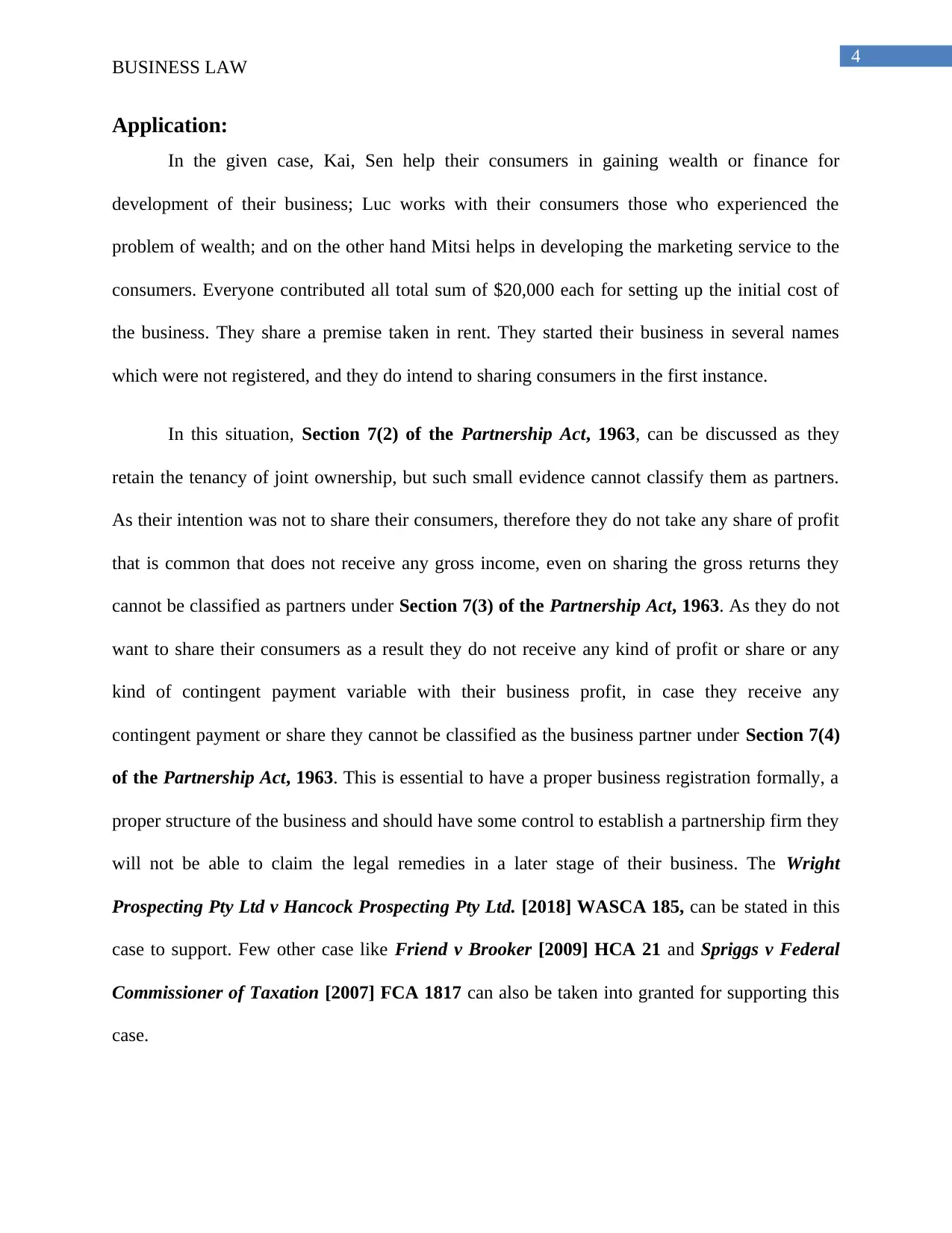
4
BUSINESS LAW
Application:
In the given case, Kai, Sen help their consumers in gaining wealth or finance for
development of their business; Luc works with their consumers those who experienced the
problem of wealth; and on the other hand Mitsi helps in developing the marketing service to the
consumers. Everyone contributed all total sum of $20,000 each for setting up the initial cost of
the business. They share a premise taken in rent. They started their business in several names
which were not registered, and they do intend to sharing consumers in the first instance.
In this situation, Section 7(2) of the Partnership Act, 1963, can be discussed as they
retain the tenancy of joint ownership, but such small evidence cannot classify them as partners.
As their intention was not to share their consumers, therefore they do not take any share of profit
that is common that does not receive any gross income, even on sharing the gross returns they
cannot be classified as partners under Section 7(3) of the Partnership Act, 1963. As they do not
want to share their consumers as a result they do not receive any kind of profit or share or any
kind of contingent payment variable with their business profit, in case they receive any
contingent payment or share they cannot be classified as the business partner under Section 7(4)
of the Partnership Act, 1963. This is essential to have a proper business registration formally, a
proper structure of the business and should have some control to establish a partnership firm they
will not be able to claim the legal remedies in a later stage of their business. The Wright
Prospecting Pty Ltd v Hancock Prospecting Pty Ltd. [2018] WASCA 185, can be stated in this
case to support. Few other case like Friend v Brooker [2009] HCA 21 and Spriggs v Federal
Commissioner of Taxation [2007] FCA 1817 can also be taken into granted for supporting this
case.
BUSINESS LAW
Application:
In the given case, Kai, Sen help their consumers in gaining wealth or finance for
development of their business; Luc works with their consumers those who experienced the
problem of wealth; and on the other hand Mitsi helps in developing the marketing service to the
consumers. Everyone contributed all total sum of $20,000 each for setting up the initial cost of
the business. They share a premise taken in rent. They started their business in several names
which were not registered, and they do intend to sharing consumers in the first instance.
In this situation, Section 7(2) of the Partnership Act, 1963, can be discussed as they
retain the tenancy of joint ownership, but such small evidence cannot classify them as partners.
As their intention was not to share their consumers, therefore they do not take any share of profit
that is common that does not receive any gross income, even on sharing the gross returns they
cannot be classified as partners under Section 7(3) of the Partnership Act, 1963. As they do not
want to share their consumers as a result they do not receive any kind of profit or share or any
kind of contingent payment variable with their business profit, in case they receive any
contingent payment or share they cannot be classified as the business partner under Section 7(4)
of the Partnership Act, 1963. This is essential to have a proper business registration formally, a
proper structure of the business and should have some control to establish a partnership firm they
will not be able to claim the legal remedies in a later stage of their business. The Wright
Prospecting Pty Ltd v Hancock Prospecting Pty Ltd. [2018] WASCA 185, can be stated in this
case to support. Few other case like Friend v Brooker [2009] HCA 21 and Spriggs v Federal
Commissioner of Taxation [2007] FCA 1817 can also be taken into granted for supporting this
case.
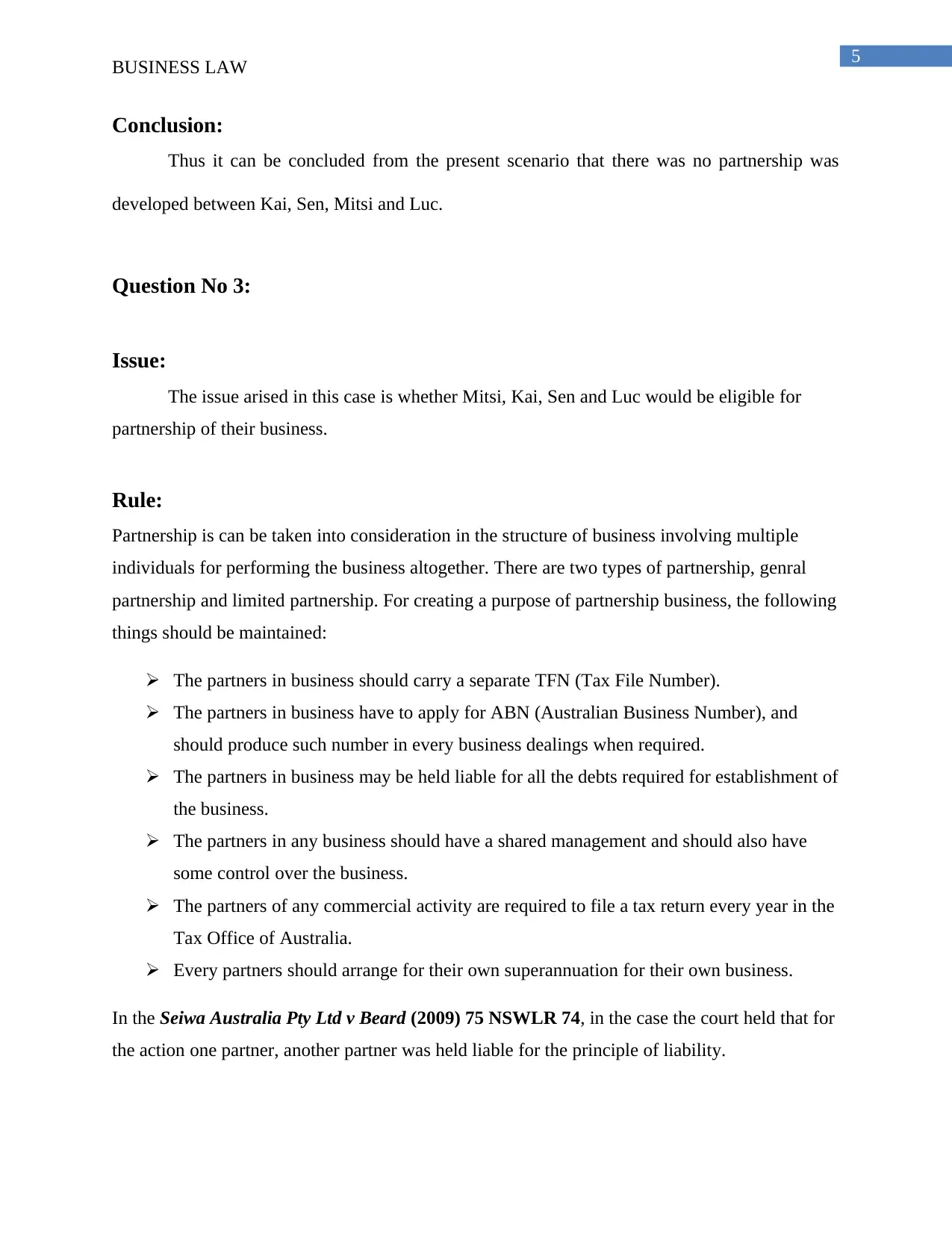
5
BUSINESS LAW
Conclusion:
Thus it can be concluded from the present scenario that there was no partnership was
developed between Kai, Sen, Mitsi and Luc.
Question No 3:
Issue:
The issue arised in this case is whether Mitsi, Kai, Sen and Luc would be eligible for
partnership of their business.
Rule:
Partnership is can be taken into consideration in the structure of business involving multiple
individuals for performing the business altogether. There are two types of partnership, genral
partnership and limited partnership. For creating a purpose of partnership business, the following
things should be maintained:
The partners in business should carry a separate TFN (Tax File Number).
The partners in business have to apply for ABN (Australian Business Number), and
should produce such number in every business dealings when required.
The partners in business may be held liable for all the debts required for establishment of
the business.
The partners in any business should have a shared management and should also have
some control over the business.
The partners of any commercial activity are required to file a tax return every year in the
Tax Office of Australia.
Every partners should arrange for their own superannuation for their own business.
In the Seiwa Australia Pty Ltd v Beard (2009) 75 NSWLR 74, in the case the court held that for
the action one partner, another partner was held liable for the principle of liability.
BUSINESS LAW
Conclusion:
Thus it can be concluded from the present scenario that there was no partnership was
developed between Kai, Sen, Mitsi and Luc.
Question No 3:
Issue:
The issue arised in this case is whether Mitsi, Kai, Sen and Luc would be eligible for
partnership of their business.
Rule:
Partnership is can be taken into consideration in the structure of business involving multiple
individuals for performing the business altogether. There are two types of partnership, genral
partnership and limited partnership. For creating a purpose of partnership business, the following
things should be maintained:
The partners in business should carry a separate TFN (Tax File Number).
The partners in business have to apply for ABN (Australian Business Number), and
should produce such number in every business dealings when required.
The partners in business may be held liable for all the debts required for establishment of
the business.
The partners in any business should have a shared management and should also have
some control over the business.
The partners of any commercial activity are required to file a tax return every year in the
Tax Office of Australia.
Every partners should arrange for their own superannuation for their own business.
In the Seiwa Australia Pty Ltd v Beard (2009) 75 NSWLR 74, in the case the court held that for
the action one partner, another partner was held liable for the principle of liability.
⊘ This is a preview!⊘
Do you want full access?
Subscribe today to unlock all pages.

Trusted by 1+ million students worldwide
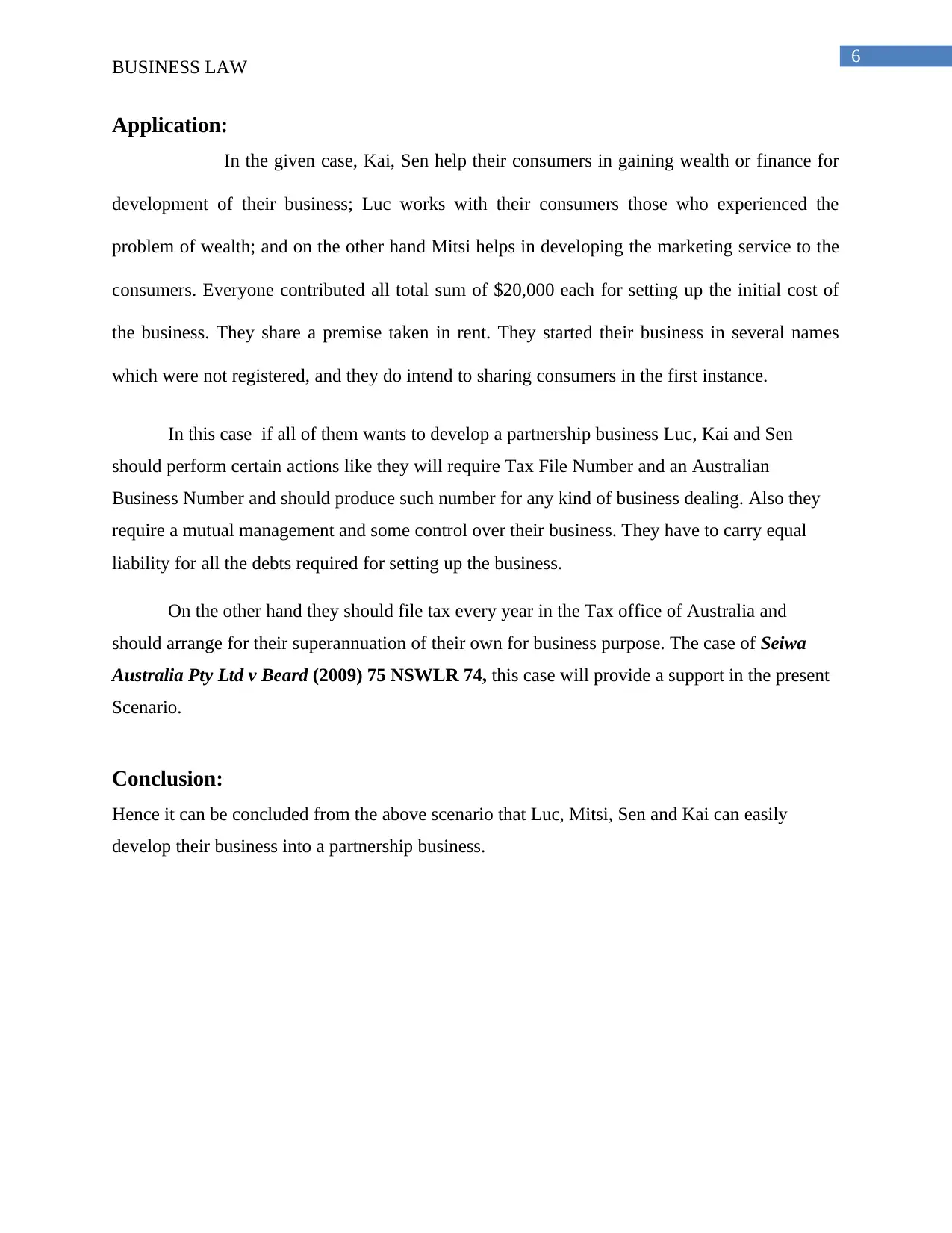
6
BUSINESS LAW
Application:
In the given case, Kai, Sen help their consumers in gaining wealth or finance for
development of their business; Luc works with their consumers those who experienced the
problem of wealth; and on the other hand Mitsi helps in developing the marketing service to the
consumers. Everyone contributed all total sum of $20,000 each for setting up the initial cost of
the business. They share a premise taken in rent. They started their business in several names
which were not registered, and they do intend to sharing consumers in the first instance.
In this case if all of them wants to develop a partnership business Luc, Kai and Sen
should perform certain actions like they will require Tax File Number and an Australian
Business Number and should produce such number for any kind of business dealing. Also they
require a mutual management and some control over their business. They have to carry equal
liability for all the debts required for setting up the business.
On the other hand they should file tax every year in the Tax office of Australia and
should arrange for their superannuation of their own for business purpose. The case of Seiwa
Australia Pty Ltd v Beard (2009) 75 NSWLR 74, this case will provide a support in the present
Scenario.
Conclusion:
Hence it can be concluded from the above scenario that Luc, Mitsi, Sen and Kai can easily
develop their business into a partnership business.
BUSINESS LAW
Application:
In the given case, Kai, Sen help their consumers in gaining wealth or finance for
development of their business; Luc works with their consumers those who experienced the
problem of wealth; and on the other hand Mitsi helps in developing the marketing service to the
consumers. Everyone contributed all total sum of $20,000 each for setting up the initial cost of
the business. They share a premise taken in rent. They started their business in several names
which were not registered, and they do intend to sharing consumers in the first instance.
In this case if all of them wants to develop a partnership business Luc, Kai and Sen
should perform certain actions like they will require Tax File Number and an Australian
Business Number and should produce such number for any kind of business dealing. Also they
require a mutual management and some control over their business. They have to carry equal
liability for all the debts required for setting up the business.
On the other hand they should file tax every year in the Tax office of Australia and
should arrange for their superannuation of their own for business purpose. The case of Seiwa
Australia Pty Ltd v Beard (2009) 75 NSWLR 74, this case will provide a support in the present
Scenario.
Conclusion:
Hence it can be concluded from the above scenario that Luc, Mitsi, Sen and Kai can easily
develop their business into a partnership business.
Paraphrase This Document
Need a fresh take? Get an instant paraphrase of this document with our AI Paraphraser
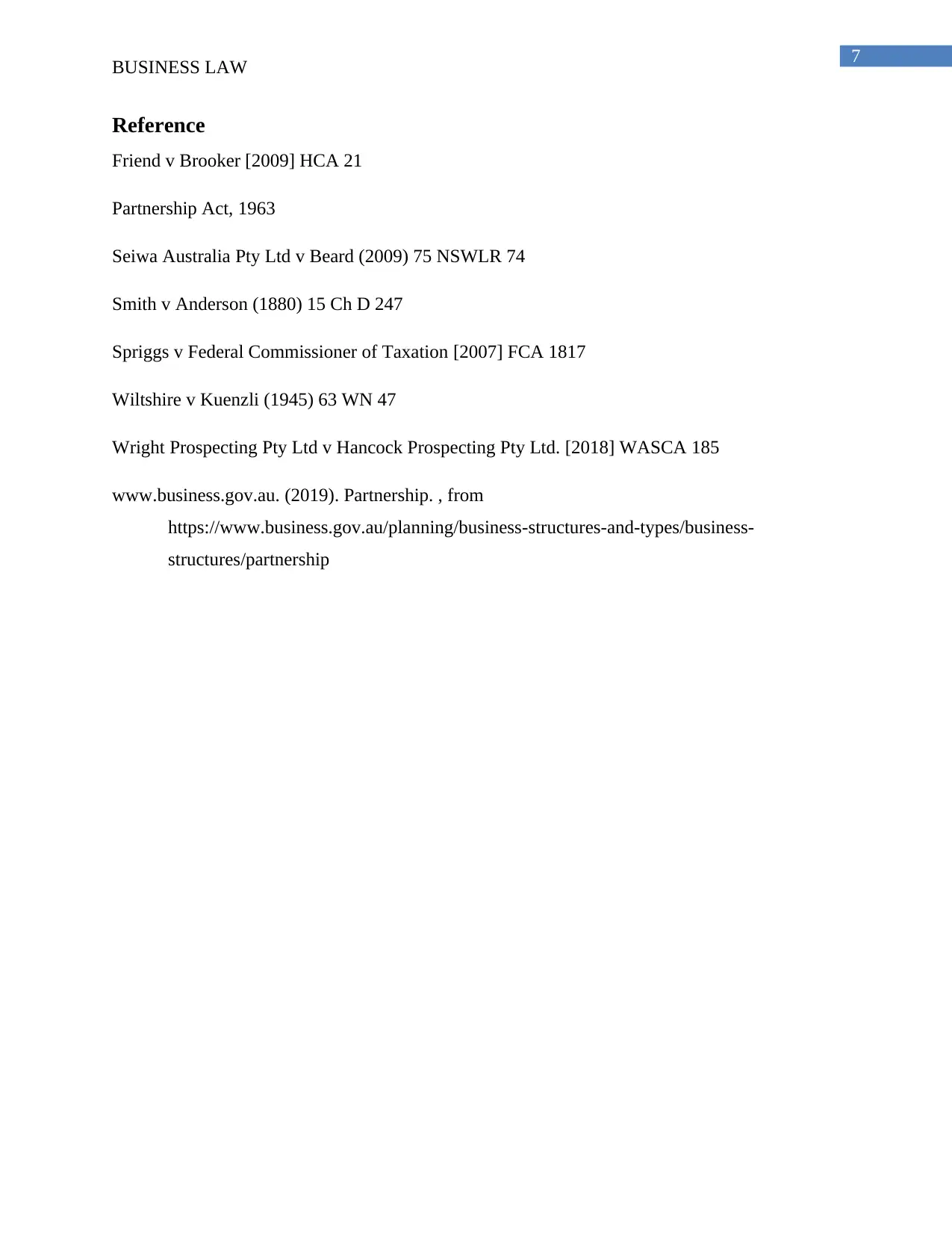
7
BUSINESS LAW
Reference
Friend v Brooker [2009] HCA 21
Partnership Act, 1963
Seiwa Australia Pty Ltd v Beard (2009) 75 NSWLR 74
Smith v Anderson (1880) 15 Ch D 247
Spriggs v Federal Commissioner of Taxation [2007] FCA 1817
Wiltshire v Kuenzli (1945) 63 WN 47
Wright Prospecting Pty Ltd v Hancock Prospecting Pty Ltd. [2018] WASCA 185
www.business.gov.au. (2019). Partnership. , from
https://www.business.gov.au/planning/business-structures-and-types/business-
structures/partnership
BUSINESS LAW
Reference
Friend v Brooker [2009] HCA 21
Partnership Act, 1963
Seiwa Australia Pty Ltd v Beard (2009) 75 NSWLR 74
Smith v Anderson (1880) 15 Ch D 247
Spriggs v Federal Commissioner of Taxation [2007] FCA 1817
Wiltshire v Kuenzli (1945) 63 WN 47
Wright Prospecting Pty Ltd v Hancock Prospecting Pty Ltd. [2018] WASCA 185
www.business.gov.au. (2019). Partnership. , from
https://www.business.gov.au/planning/business-structures-and-types/business-
structures/partnership

8
BUSINESS LAW
BUSINESS LAW
⊘ This is a preview!⊘
Do you want full access?
Subscribe today to unlock all pages.

Trusted by 1+ million students worldwide

9
BUSINESS LAW
BUSINESS LAW
1 out of 10
Related Documents
Your All-in-One AI-Powered Toolkit for Academic Success.
+13062052269
info@desklib.com
Available 24*7 on WhatsApp / Email
![[object Object]](/_next/static/media/star-bottom.7253800d.svg)
Unlock your academic potential
Copyright © 2020–2025 A2Z Services. All Rights Reserved. Developed and managed by ZUCOL.




